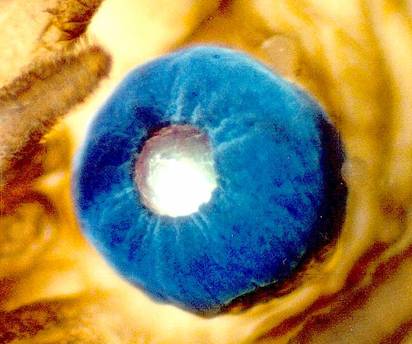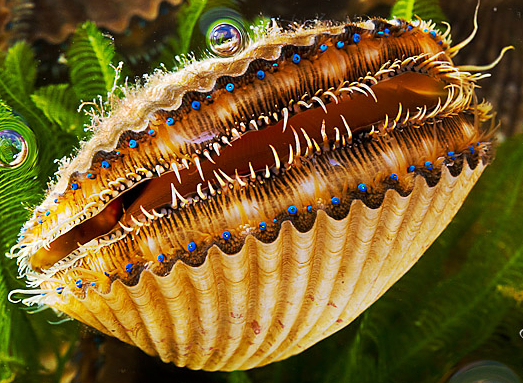

Left: eye of a scallop, about a millimeter in diameter. Right: picture of a scallop, showing the many blue eyes in context. The right picture was taken by David Moynahan.


This picture raises a further interesting question that is answered in Physics 162: how does a scallop (or any silvery fish) produce a shiny reflecting surface without using any metal? The answer has to do with the interference of light, based on its wave-like properties. You will learn in 162 that, if one can create alternating layers of different transparent media (think of successive layers of clear jello), and the alternating layers have different indices of refraction, then by carefully choosing the thickness of each layer, one can arrange for light that reflects at each interface to interfere constructively such that all incoming light (within a certain range of wavelengths) is reflected back toward its source, that is the layers act as a high quality mirror. It is fairly easy for biological creatures to secrete such alternating clear layers with slightly different properties, rather harder for humans to do so using chemical and mechanical engineering.
Once light reaches the scallop's
retina, many ideas of Physics 162 such as charge conservation,
electric potential, capacitance, resistance, and dielectrics become
important for understanding how the light initiates the formation of
an electrical current, and how the current propagates down the
non-metallic "wires" (called axons) that connect one nerve to another,
eventually leading to behavior. The
so-called Hodgkin-Huxley
equations, a mathematical expression for the conservation of
charge as charge flows across and along a neuron's membrane in
response to various voltage-sensitive membrane proteins that can open
and close holes in the membrane, gives a valuable quantitatively
accurate description of signal propagation in nervous systems. The
Hodgkin-Huxley equations were, in turn, motivated by earlier
theoretical work
of Lord
Kelvin around 1850 to understand how signals propagated in leaky
underwater electrical cables that linked Europe to the United
States. The importance of this early communication network led to the
creation of the first electrical engineering departments, whose
initial goal was to train people to solve the Maxwell equations of
electrodynamics in the context of cables and so improve the
engineering of such cables. Similarly, electrodynamics is profoundly
important in the operation of the Internet, in which huge amounts of
information are transmitted in the form
of solitonic light
pulses through ultraclear glass fibers.